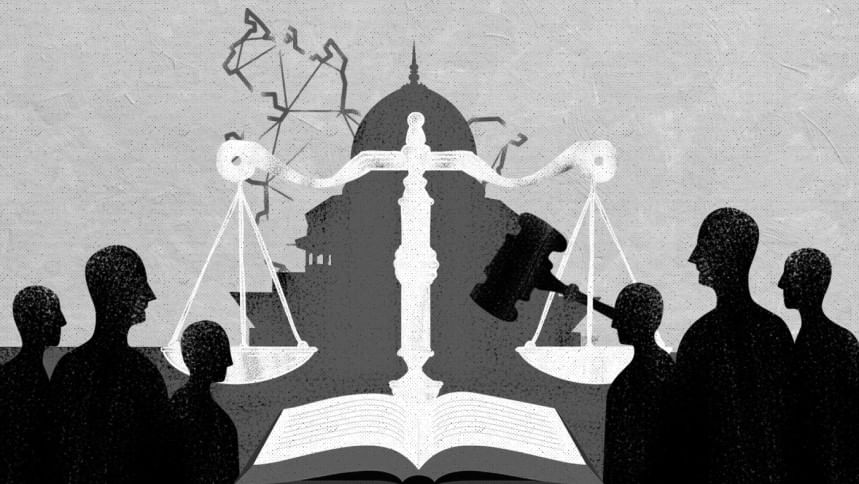Decentralising the High Court: Between consensus and constitutional constraints

In a rare moment of unity, political parties in early July reached a consensus on establishing permanent benches of the High Court in divisional headquarters. This agreement, struck during discussions with the National Consensus Commission, comes with the understanding that Article 100 of the constitution will be amended. Therefore, the permanent seat of the Supreme Court remains in Dhaka, but one or more permanent benches of the High Court will operate at the divisional level, subject to consultation with the chief justice.
The logic behind such decentralisation is compelling. The Judiciary Reform Commission (JRC), in its report, had strongly recommended expanding the judiciary by setting up permanent High Court benches in every divisional city. The aim is to address the staggering backlog—currently over 5.77 lakh pending cases in the High Court Division alone—and to make justice more accessible. Today, all the High Court benches are housed in the Supreme Court buildings in Dhaka. This forces litigants from all corners of the country to make costly, time-consuming trips to the capital for hearings. By distributing permanent benches across divisions, justice could be delivered faster and closer to the people it serves.
The JRC stressed that each permanent bench should have a clearly defined jurisdiction in terms of the areas from which it can receive cases, while retaining the full jurisdiction of the High Court Division to issue judgments, orders, and directions. In other words, decentralisation should not fragment the High Court's constitutional authority nor undermine the unitary nature of the state. Adequate infrastructure—courtrooms, judges' chambers, support staff, and budgets—would be essential. Implementation could proceed in phases, prioritising the most urgent divisions first.
The Constitution Reform Commission (CRC) made a similar recommendation, albeit with a slightly different model: permanent "seats" of the High Court in all divisions, while keeping the Appellate Division in the capital. Both the CRC and the JRC recognise that implementing either model—benches or seats—will require amending Article 100, which currently states: "The permanent seat of the Supreme Court shall be in the capital, but sessions of the High Court Division may be held at such other place or places as the Chief Justice may, with the approval of the President, from time to time appoint." In its present form, Article 100 only allows for temporary "sessions" outside Dhaka, not permanent benches or seats.
If this sounds familiar, it is because we have been here before. Between 1982 and 1986, several permanent benches were set up outside the capital under martial law proclamations. In 1988, the parliament amended Article 100 through the Eighth Amendment to establish six permanent benches in Barishal, Chattogram, Cumilla, Jashore, Rangpur, and Sylhet. This attempt at decentralisation was short-lived.
In the landmark Eighth Amendment Case (Anwar Hussain Chowdhury vs. Bangladesh, 1989), the Appellate Division struck down the amendment as void and unconstitutional, marking the first time in Bangladesh that a constitutional amendment passed by parliament was invalidated. The court applied the "basic structure" doctrine, holding that certain fundamental features of the constitution—such as the supremacy of the constitution, separation of powers, independence of the judiciary, and the "oneness" of the High Court Division—cannot be altered even by a two-thirds majority in parliament.
The majority opinion was clear: creating multiple permanent benches with full jurisdiction amounted to setting up rival courts to the High Court Division, violating its oneness and the unitary character of the republic. The lack of provisions for transferring cases between benches effectively turned each bench into a separate and distinct court, undermining the essential limb of the judiciary.
Today's decentralisation debate must grapple with this binding precedent. Opponents of reform, particularly some within the legal community, argue that any such move threatens the unitary structure of the judiciary and risks violating the constitution. Proponents counter that the realities of 2025 are drastically different from those of 1989, and that the constitution is a living instrument capable of adapting to contemporary needs. Proponents propose three potential paths forward: first, design a model in which all permanent seats have plenary jurisdiction without territorial limits, with case allocation managed internally by the Supreme Court; second, adopt a fresh constitutional interpretation that reflects present-day demographic, economic, and judicial realities; and third, enact a referendum-based constitutional amendment exercising constituent power, which would stand beyond the reach of the basic structure doctrine.
However, the Eighth Amendment case is no longer the only obstacle. The issue must now also be viewed in light of the recent 15th Amendment Case, decided by the High Court Division on December 17, 2024, with the full judgment released in July 2025. The court reaffirmed the principles laid down in the Eighth Amendment Case in emphatic terms by revoking Article 44 (2).
Article 44(2) had allowed the parliament to empower "any other court" to exercise the High Court Division's powers to enforce fundamental rights. The High Court Division struck this down as unconstitutional, holding that within the constitutional framework, no other court can be placed on par with the High Court Division. It found Article 44(2) inconsistent with the basic structure, particularly the oneness of the High Court Division, and therefore beyond the parliament's amending power under Article 142.
The 15th Amendment judgment's endorsement of the Eighth Amendment Case, especially its emphasis on the oneness of the High Court Division, is telling. While the case did not specifically deal with decentralisation under Article 100, the reasoning strongly aligns with the position that such decentralisation risks fragmenting the High Court Division's constitutional integrity. It is difficult to ignore how this judicial stance could be read as discouraging any move towards permanent benches or seats, regardless of political consensus or reformist enthusiasm.
This leaves Bangladesh at a constitutional crossroads. On one side, we have overwhelming public support, formal recommendations from reform commissions, and cross-party political agreement to bring the High Court closer to the people. On the other, we face entrenched constitutional doctrine, reinforced as recently as last year, that resists any structural change perceived to dilute the High Court Division's unity.
The truth is, decentralisation of the High Court cannot be addressed through political will alone. Any reform must survive constitutional scrutiny under the basic structure doctrine as interpreted by our highest courts. This will require more than a straightforward amendment to Article 100—it will demand careful constitutional engineering, perhaps even a direct exercise of constituent power through the people themselves.
Until then, the promise of a more accessible and efficient High Court will remain an aspiration caught between two powerful forces: the undeniable need for reform and the unyielding guardrails of constitutional doctrine. Whether we can reconcile the two will determine not only the future of our judiciary but also the balance between stability and adaptability in our constitutional order.
Barrister Khan Khalid Adnan is an advocate at the Supreme Court of Bangladesh, fellow at the Chartered Institute of Arbitrators, and head of the chamber at Khan Saifur Rahman and Associates in Dhaka.
Views expressed in this article are the author's own.
Follow The Daily Star Opinion on Facebook for the latest opinions, commentaries and analyses by experts and professionals. To contribute your article or letter to The Daily Star Opinion, see our guidelines for submission.

 For all latest news, follow The Daily Star's Google News channel.
For all latest news, follow The Daily Star's Google News channel. 









Comments